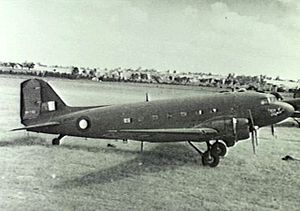No. 300 Group RAF
| No. 300 Group | |
|---|---|

A RAF Douglas Dakota at Camden Airport in 1945
|
|
| Active | 1944–46 |
| Country | United Kingdom |
| Branch | Royal Air Force |
| Role | Air transport |
| Part of | British Pacific Fleet |
| Commanders | |
| Notable commanders |
Alfred Earle |
No. 300 Group was a Royal Air Force group of World War II. It was formed in Australia in late 1944 as No. 300 Wing with the role of providing air transport for the British Pacific Fleet (BPF), and was redesignated as a group in 1945. It transported BPF supplies and personnel around Australia and to the fleet's forward bases in the Philippines and Manus Island. The group was disbanded in April 1946.
No. 300 Wing RAF was established at Mascot Airport in Sydney in late 1944 to provide the British Pacific Fleet with a means of rapidly transporting personnel, essential supplies and mail. The wing (and later group) came under the control of the commander of the BPF, Admiral Sir Bruce Fraser, and was the only RAF unit to be directly assigned to a Royal Navy fleet commander during World War II.
In February 1945 No. 300 Wing comprised two flying units: No. 243 Squadron equipped with 30 Douglas Dakotas and No. 1315 Flight with 6 Consolidated B-24 Liberators. Two of the Liberators were fitted as VIP transports, and were used by Fraser and other senior officers. Many of No. 243 Squadron's personnel were Australians. While the wing's main base was at Camden Airport to the west of Sydney, its headquarters was located in the Melbourne suburb of South Yarra to liaise with the headquarters of the Royal Australian Air Force.
During early 1945 the wing established a regular service from Sydney to the BPF's forward base at Manus Island off the north coast of New Guinea; by March these flights operated daily. Regular services to the BPF's logistical hub at Leyte Gulf in the Philippines began in April 1945, and a route to Enewetak Atoll (a key base for BPF tankers) was added in July that year. Thrice-weekly services were also flown to San Diego in the United States, and a regular route was established to Colombo in Ceylon. Parties of servicing personnel were established at each of these destinations and several staging points in Australia and New Guinea.
...
Wikipedia
